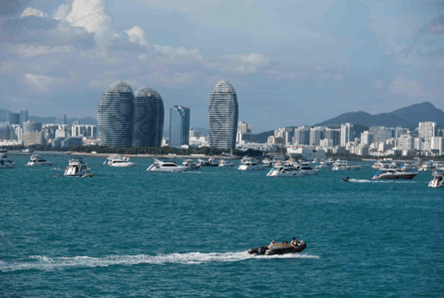Hainan Free Trade Port gains momentum as China deepens high-level opening up
As one of the most significant hallmarks of reform, the Hainan FTP is positioning itself as a platform for institutional innovation, a hub for regional and global cooperation, and a new engine of international economic integration. It reflects China’s willingness to share its development opportunities and to pursue partnerships worldwide.

By Pei Guangjiang and Yu Yichun, People’s Daily
Special to The Times Kuwait
China’s Hainan Free Trade Port (FTP) is set to achieve a historic milestone on December 18, 2025, with the launch of island-wide independent customs operations. This development sends a clear signal to the world: China is unwavering in its commitment to deeper reform and high-level opening up, even as protectionist currents gain strength globally.
The creation of the Hainan FTP was a strategic reform personally planned and advanced by President Xi Jinping. Over the past seven years, the FTP has taken shape by combining the strength of China’s vast domestic market with international trade rules of the highest standard. Today, it has become a magnet for both domestic and global investors, symbolizing China’s openness in the new era.
As one of the most significant hallmarks of reform, the Hainan FTP is positioning itself as a platform for institutional innovation, a hub for regional and global cooperation, and a new engine of international economic integration. It reflects China’s willingness to share its development opportunities and to pursue partnerships worldwide.

The introduction of independent customs operations is not about seclusion but rather about a deeper level of opening up. Tariff items eligible for zero-tariff treatment will expand to around 6,600—covering about 74 percent of all tariff items, a leap of nearly 53 percentage points. The FTP will also adopt a low-intervention regulatory model, simplifying supervision for zero-tariff goods and easing controls on goods under relaxed management.
These operations will be managed through two distinct customs “lines.” The “first line” will link the FTP with economies beyond China’s customs territory, ensuring the smooth flow of zero-tariff goods under streamlined policies. The “second line” will connect the FTP with the Chinese mainland, where tailored oversight will protect the domestic market. Goods and processed products within the FTP can be stored indefinitely, giving enterprises unprecedented flexibility.
Alongside customs reforms, the Hainan FTP will implement favorable tariff policies, simplified trade procedures, streamlined travel and logistics measures, and targeted regulatory oversight. With both institutional “software” and physical “hardware” in place, Hainan is set to emerge as a modern and globally connected hub that injects fresh vitality into China’s high-quality growth, while serving as a benchmark for higher-level opening up.
Unlike earlier models of opening up that centered on the flow of goods and production factors, the Hainan FTP represents “institutional opening up” that focuses on rules, regulations, management, and standards. By aligning with the world’s most advanced open economies, it aims to create a more predictable regulatory environment and wider opportunities for global businesses.
Evidence of its success is already visible. Despite global uncertainties, more than 2,000 new foreign-invested firms were registered in Hainan in 2024, up nearly 20 percent year-on-year. At the 2025 Global Industrial Investment Promotion Conference held in April, 265 projects worth around 233.6 billion yuan ($32.44 billion) were signed. Investors from 176 countries and regions have entered the Hainan market, and the province’s openness ratio has climbed to 35 percent—proof of international confidence in China’s reform agenda.
The timing of this progress is particularly significant. With unilateralism and protectionism on the rise and globalization facing severe challenges, China’s determination to remain open takes on global importance. Since launching its first pilot free trade zone in Shanghai in 2013, China has consistently used FTZs and the Hainan FTP to dismantle institutional barriers, lower trade costs, and boost the free flow of resources, contributing new momentum to the world economy.
China continues to shorten the negative list for foreign investment and expand its network of high-standard free trade agreements. The scope, depth, and quality of China’s opening up are steadily increasing, ensuring that the benefits of reform are widely shared. These consistent efforts demonstrate that high-level opening up is not a temporary tactic, but a long-term strategic choice that aligns with both global trends and China’s national development goals.
The progress of the Hainan FTP stands as living proof of China’s evolving opening-up model. Looking forward, China will keep pursuing higher-level openness as a driver of high-quality growth, while contributing more actively to building an open global economy and advancing a community with a shared future for mankind.
Follow The Times Kuwait on
X, Instagram and Facebook for the latest news updates













